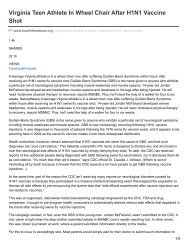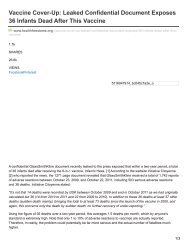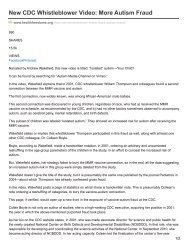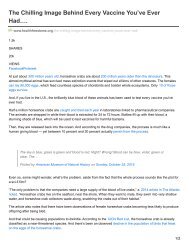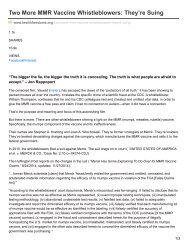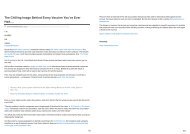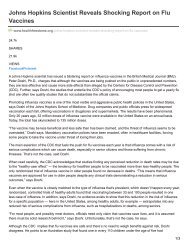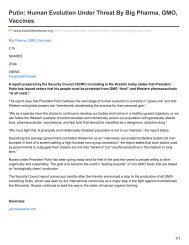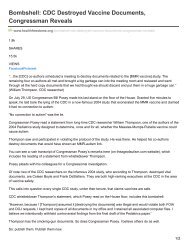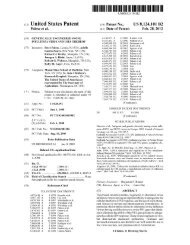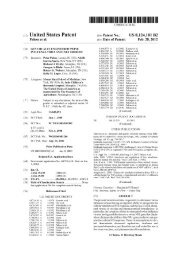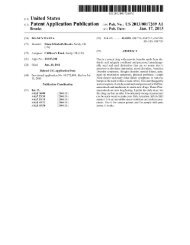healthfreedoms.org-Six Drugs Whose Dangerous Risks Were Buried So Big Pharma Could Make Money
Create successful ePaper yourself
Turn your PDF publications into a flip-book with our unique Google optimized e-Paper software.
<strong>Six</strong> <strong>Drugs</strong> <strong>Whose</strong> <strong>Dangerous</strong> <strong>Risks</strong> <strong>Were</strong> <strong>Buried</strong> <strong>So</strong> <strong>Big</strong><br />
<strong>Pharma</strong> <strong>Could</strong> <strong>Make</strong> <strong>Money</strong><br />
www.<strong>healthfreedoms</strong>.<strong>org</strong> /six-drugs-whose-dangerous-risks-were-buried-so-big-pharma-could-make-money/<br />
<strong>Big</strong> <strong>Pharma</strong><br />
1.8k<br />
SHARES<br />
28.8k<br />
VIEWS<br />
FacebookPinterest<br />
opioid30p1<br />
New meds are rushed to the market so industry can start making money even before safety has been determined.<br />
When a prescription drug causes risky side effects, the word often doesn’t get out for years, allowing <strong>Big</strong> <strong>Pharma</strong> to<br />
make money anyway.<br />
The FDA and <strong>Big</strong> <strong>Pharma</strong> contend that dangerous side-effects in a prescription drug only emerge when it is used by<br />
millions instead of the relatively small group of people in clinical trials. But there is another reason the public ends up<br />
guinea pigs. Prescription drugs are rushed to market in as little as six months so industry can start making<br />
money while safety is still being determined. Both Merck’s risk-laden bone drug Fosamax and painkiller Vioxx were<br />
on the market after a six-month review. In the case of Vioxx, it was because “the drug potentially provided a<br />
significant therapeutic advantage over existing approved drugs,” the FDA said.<br />
Thanks for that. And five drugs (Trovan, Rezulin, Posicor, Duract and Meridia) rushed through in 1997 because of<br />
<strong>Pharma</strong> and congressional pressure on the FDA, says Public Citizen, were subsequently withdrawn.<br />
Here are some drugs whose risks did not did not keep them from getting their “patent’s worth.”<br />
1. Singulair<br />
You’d think Merck would have learned from Vioxx and Fosamax that aggressive marketing can only hide emerging<br />
risks for so long. It didn’t. To sell its asthma and allergy drug Singulair to children, the drug giant partnered with<br />
1/4
Olympic gold-medalist swimmer Peter Vanderkaay and Scholastic and the American Academy of Pediatrics even as<br />
the FDA warned about “neuropsychiatric events” including agitation, aggression, nightmares, depression, insomnia<br />
and suicidal thinking.<br />
While Merck marketed Singulair, which comes in a cherry-flavored chewable formulation, to parents with slogans<br />
like “Singulair is made with kids in mind,” Fox TV and over 200 parents on the website askapatient reported that<br />
children on Singulair exhibited altered moods, depression and ADHD, hyperkinesis and suicidal symptoms. Fifteenyear-old<br />
Cody Miller of Queensbury, NY reportedly took his own life days after taking the drug in 2008. Still,<br />
Singulair made $5 billion for the company in 2010. After its patent expired in 2012, Australia’s Therapeutic Goods<br />
Administration, the FDA’s counterpart, reported 58 cases of adverse psychiatric events in children and teenagers,<br />
primarily suicidal thinking. Who knew?<br />
2. Zyprexa<br />
How do you sell a drug that causes 30 percent of users to gain 22 pounds and some to gain as much as 100<br />
pounds? By burying the risks. The antipsychotic Zyprexa was supposed to be Eli Lilly’s followup to its blockbuster<br />
antidepressant Prozac even though Lilly knew as early as 1995, according to the New York Times, that Zyprexa<br />
was linked to unmanageable weight gain or diabetes. Zyprexa’s side effects of “weight gain and possible<br />
hyperglycemia is a major threat to the long-term success of this critically important molecule,” wrote Lilly’s Alan<br />
Breier, who later became chief medical officer, in documents obtained by the Times.<br />
Even as Lilly settled charges that it withheld the drug’s link to high blood sugar levels and diabetes and illegally<br />
marketed the drug for dementia, Zyprexa made $5 billion in 2010 and out-earned Prozac. Who says crime doesn’t<br />
pay? Zyprexa was especially marketed to the poor and became one of the nation’s top Medicaid drugs extracting at<br />
least $1.3 billion of our tax dollars in 2005 alone. In 2008, Lilly settled an Alaskan suit to cover the cost of Medicaid<br />
patients who developed diabetes on Zyprexa. Unbelievably, Lilly offered a “free service” to “help” states buy mental<br />
illness drugs like Zyprexa as a fox guards the henhouse and 20 states took the bait. Zyprexa’s patent ran out in<br />
2012.<br />
3. Seroquel<br />
Like Zyprexa, the antipsychotic Seroquel, made by the UK firm AstraZeneca, became a best-selling medication in<br />
the US, earning over $5 billion in 2010, despite frequently reported risks. It was so heavily marketed to poor children<br />
that in 2007, Florida’s Department of Juvenile Justice’s bought twice as much Seroquel as Advil. Seroquel’s high<br />
use in the military for the unapproved uses of sleep and PTSD was also disturbing: reports of veterans’ sudden<br />
deaths on the drug, thought to be cardiac-related, surfaced even as use of Seroquel soared 700 percent in the<br />
Department of Defense. In 2009, it was the number-two drug at the VA, accounting for $125.4 million in tax dollars.<br />
Months after Seroquel’s 1997 approval, an article in the <strong>So</strong>uth Dakota Journal of Medicine raised questions about<br />
the drug’s unsafe interaction with 11 other drugs. Within three years, researchers at the Cleveland Clinic were<br />
questioning Seroquel’s effect on the heart’s electrical activity. But even as the families of deceased veterans testified<br />
at FDA hearings in 2009 and demanded answers from officials and lawmakers, the FDA maintained Seroquel’s<br />
safety. Then in 2011, with little fanfare, the FDA issued new warnings that corroborated the swirling suspicions: both<br />
Seroquel and its extended release version “should be avoided” in combination with at least 12 other medicines, said<br />
the FDA. The drug should also be avoided in the elderly and people with heart disease because of clear<br />
cardiac risks. Oops. Seroquel’s patent ran out the following year.<br />
4. Levaquin<br />
Fluoroquinolone antibiotics are among the biggest-selling drug classes. Many people remember the fluoroquinolone<br />
Cipro (given for 9/11-era anthrax attacks) but <strong>Pharma</strong> hopes we don’t remember the fluoroquinolones Trovan, which<br />
was withdrawn for causing liver damage, and Raxar, which was withdrawn for causing cardiac events and sudden<br />
2/4
death. Johnson & Johnson’s fluoroquinolone Levaquin was the US’ best-selling antibiotic in 2010 with sales over<br />
a $1 billion a year but is now the subject of thousands of lawsuits.<br />
In 2012, a year after Levaquin’s patent expired, a cascade of side effects began to emerge with Levaquin and the<br />
whole class of fluoroquinolones that casts doubt about their safety. The Journal of the American Medical<br />
Association reported that of 4,384 patients diagnosed with retinal detachment, 445 (10 percent) were exposed to a<br />
fluoroquinolone in the year before diagnosis. The New England Journal of Medicine reported the same year that<br />
Levaquin was linked to an increased risk of cardiovascular death, especially sudden death from heart rhythm<br />
disturbances.<br />
While the FDA warned of tendon ruptures on fluoroquinolones, especially Achilles’ tendons in 2008, and added a<br />
black box warning on the label, it had a serious new warning two years after Levaquin went off patent. In 2013,<br />
the FDA warned about the “the serious side effect of peripheral neuropathy” in fluoroquinolones, a type of nerve<br />
damage in which sensory pathways are impaired. Peripheral neuropathy caused by fluoroquinolones like Levaquin<br />
can “occur soon after these drugs are taken and may be permanent,” warned the FDA. Fluoroquinolones are<br />
also linked to Clostridium difficile, also called C. Diff, a serious and potentially deadly intestinal microbe.<br />
5. Topamax<br />
Before its patent expired in 2009, the seizure drug Topamax made Johnson & Johnson a billion a year and it still<br />
made $538 million a year after its patent expiration. Topamax was such a favorite for pain conditions in the military it<br />
was given the nickname “Stupamax” for the way it slowed reaction times and impaired motor skills, attention and<br />
memory, according to Army Times. Not too great for combat.<br />
A year before Topamax went off patent, the FDA warned that it and other seizure drugs are correlated with<br />
suicide and asked their manufacturers to add label warnings. Four patients on the drugs killed themselves versus<br />
none on placebo reported the FDA after reviewing clinical trials. Then, in 2011, the FDA announced that Topamax<br />
can cause the birth defects cleft lip and cleft palate in babies of mothers who take the drug. “Before starting<br />
topiramate, pregnant women and women of childbearing potential should discuss other treatment options with their<br />
healthcare professional,” the FDA warned, though the risks did not stop the FDA from approving a new diet drug<br />
containing Topamax’ generic drug in 2012.<br />
6. Oxycontin<br />
Purdue <strong>Pharma</strong>’s Oxycontin is the granddaddy of drugs that make money despite lethal side-effects. Along with<br />
other prescription opioids, it accounted for an astounding 17,000 deaths last year—four times that in 2003. “The<br />
increase [in use] has been fueled in part by doctors and pain advocacy <strong>org</strong>anizations that receive money from drug<br />
companies and make misleading claims about the safety and effectiveness of opioids, including that addiction is<br />
rare,” reported the Journal Sentinel.The American Geriatrics <strong>So</strong>ciety used <strong>Pharma</strong>-linked experts to rewrite clinical<br />
guidelines in 2009, says the Journal Sentinel, which specified opioids for all patients with moderate to severe<br />
pain as opposed to Aleve or Advil. Ka-ching.<br />
Oxycontin, because it is a long-acting formulation, was supposed to reduce toxicities and addictiveness—at least<br />
until its crush, snort and shoot potential made it more popular than cocaine on the street. (All the pill’s 80mg could<br />
be taken at once.) In 2010, responding to the addictions, overdoses, deaths and diversions associated with the<br />
drug, Purdue rolled out a tamper-resistant Oxycontin and began to push for state and federal laws requiring opioids<br />
to be tamper-resistant in 2012. Purdue said public health was its main concern but many are asking why that<br />
concern only surfaced as Oxycontin’s patent was expiring. Its patent expired in 2013.<br />
<strong>So</strong>urce(s):<br />
alternet.<strong>org</strong><br />
3/4
worldtruth.tv<br />
4/4




